|
|
|
Sort Order |
|
|
|
Items / Page
|
|
|
|
|
|
|
| Srl | Item |
| 1 |
ID:
151479
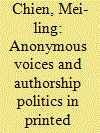

|
|
|
|
|
| Summary/Abstract |
This paper analyzes two versions of a printed genealogy collated by the Hmub and Kam in Eastern Guizhou, who gave authority to claims of consanguine bonds. It focuses on how the main text of the genealogy and other intertextual practices can either attribute authority to the genealogies or undermine it. On the one hand, elite accounts of ancestors in the genealogies invent a strong ideology of consanguinity that directly contributes to the text’s authority. At the same time, however, the use of Chinese characters to represent the Hmub phonetic system coexists with the Hmub system of patronymy within the assemblage of the individual descendant names. In other words, Chinese characters represent nonpersonal phonetic symbols of the Hmub language. This in turn means that anonymous voices can emerge in other texts. The result is a shift in the nature of authorship from an overtly collective authority to a covertly diffused anonymity.
|
|
|
|
|
|
|
|
|
|
|
|
|
|
|
|
| 2 |
ID:
095458


|
|
|
|
|
| Publication |
2010.
|
| Summary/Abstract |
This article investigates the practice and social meanings of cross-border journeys of Dai minority monks, in Xishuangbanna, Southwest China. These journeys play a vital part in Theravada revivalism in this border region. In the early 1990s, the Dai monks left Xishuangbanna to pursue their Buddhist studies in Thailand, thereby experiencing Thai culture and society. I will show not only that transnational networks among the Tai peoples in the upper Mekong region have played a crucial role in this religious movement, but also that the transnational Theravada networks enable and are partly constituted by the cross-border journeys of Dai exiles and minority monks, which strengthen and enhance the Dai ability to persist, revive, and maintain their locality and cultural identity. It is these cultural practices which contribute to and formulate the making of Dai places within the power contexts of state displacement, regional trade and development in Southwest China.
|
|
|
|
|
|
|
|
|
|
|
|
|
|
|
|
| 3 |
ID:
162845
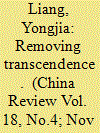

|
|
|
|
|
| Summary/Abstract |
The article analyzes primary sources about regulating Catholic and
Protestant communities in Dali, Southwest China, during the heyday of
the People’s Republic. It was a process of sophisticated containment,
in�ltration, spying, and coercion, with a corresponding restrained use
of violence. �is is surprising given that, �rst, both Catholic and Protestant communities were small and, second, that violence against other
potential threats—counterrevolutionaries and landlords—was severe. I
suggest the goal for the local Department of United Front ( 統戰部
tongzhan bu) was not to eradicate Christianity by force but to divide the
church into those who would submit themselves to the communist
utopia and isolate the hard-core devotees with the expectation that both
would eventually die out without “contaminating” the emerging
socialist subjects. �e regulatory process was one in which the state
power attempted to remove the Christian transcendence with a communist one. �e article challenges the state-society dichotomy underlying
the study of Chinese religiosity, especially the claim of “militant
atheism,” which depicts the People’s Republic of China’s early policy on
Christianity.
|
|
|
|
|
|
|
|
|
|
|
|
|
|
|
|
| 4 |
ID:
140128


|
|
|
|
|
| Summary/Abstract |
Development of peripheries has always been a major challenge for large states. One of the drivers of the underdevelopment of the peripheries has been the traditional state-centric security perception. As a result, state-led development suffers from a built-in bias against the peripheries. Market signals emanating from the operation of the national economy are not strong enough to bring the resources of the peripheries into immediate use. This is the theoretical rationale to look beyond the framework of the national economy and the state-centric mindset while formulating the development strategy for border areas. Sub-regional cooperation like Bangladesh–China–India–Myanmar Forum for Regional Cooperation (BCIM) has the potential to promote growth in southwest China, Bangladesh, Myanmar and northeast India by way of utilising the complementarities of these regions. The mobilisation of cross-border synergies is destined to make the BCIM one of the economically vibrant zones that may develop the cross-border connectivity among the land-linked areas.
|
|
|
|
|
|
|
|
|
|
|
|
|
|
|
|
| 5 |
ID:
123714
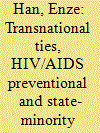

|
|
|
|
|
| Publication |
2013.
|
| Summary/Abstract |
This paper depicts the transnational ethnic and religious ties between China and Southeast Asia and examines the cultural, political and economic implications for state-minority relations in Southwest China. It documents how transnational ethnic and religious ties facilitate cultural revival among the ethnic Dai people in Southwest China and examines the impact of Buddhist networks on local governance. In particular, it portrays the cooperative relationship between the Chinese state and the Buddhist Sangha on social issues such as HIV/AIDS prevention and care. The paper argues that the Chinese state is more willing to cooperate with transnational ethnic and religious groups when the latter can help improve local governance and generate economic development, under the condition that they do not challenge the state's ultimate legitimacy and authority.
|
|
|
|
|
|
|
|
|
|
|
|
|
|
|
|
| 6 |
ID:
124660
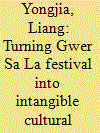

|
|
|
|
|
| Publication |
2013.
|
| Summary/Abstract |
The Gwer Sa La Festival of the Bai in southwest China was recently announced as a national Intangible Cultural Heritage Project and nominated for the United Nations Educational, Scientific and Cultural Organisation world ICH candidacy, largely due to the local government's promotion of Gwer Sa La's religiosity by constructing and materialising the rhetoric of survival by a primitive fertility cult and ethnic carnival. However, the key concern of the participants is Gwer Sa La's potency of prosperity, related to a series of encompassing powers vested in the patron god temples, taken care of by women congregations who renew the power of prosperity during the Festival. It is argued here that the state's efforts to turn Gwer Sa La into an ICH project is an attempt of "superscription without encompassment". The efforts are based on an imagined, primitive fertility cult that leads to sexual promiscuity and which entirely overlooks the locals' concerns.
|
|
|
|
|
|
|
|
|
|
|
|
|
|
|
|
| 7 |
ID:
116204
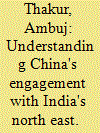

|
|
|
| 8 |
ID:
153003


|
|
|
|
|
| Summary/Abstract |
Studies on ethnic minorities for the Republican period (1912–1949) highlight the political agency these groups displayed in their negotiations with the modern Chinese state. Most of this work has focused on those non-Han groups officially recognized as part of the Five-Race Republic (wuzu gonghe). Little is known, however, about those excluded from the early Republic’s flag such as the Yi inhabiting southwest China. This article discusses the role played by a group of Yi leaders who engaged with Sun Yat-sen’s ideology of nationalism, racial equality, and anti-imperialism in their attempts to obtain both recognition and aid from the Chinese nation–state. Rather than rejecting the commonly used term to identify China’s non-Han population of ‘weak and small races’ present in Sun Yat-sen’s ideology, Yi elites appropriated this term to their advantage seeking aid from the Guomindang but at the same time placing boundaries to what they perceived to be a Han-centered state.
|
|
|
|
|
|
|
|
|
|
|
|
|
|
|
|
| 9 |
ID:
171914


|
|
|
|
|
| Summary/Abstract |
Hundreds of hydropower dam projects, of all sizes, have been initiated in Yunnan Province, China, since the late 1990s. This paper frames hydropower‐driven resource reallocations as resource grabs that combine aspects of land, water and green‐grabbing, investigating how two dams built along the Red River have impacted local communities and how corporate and governmental stakeholders have viewed local livelihood changes and considered compensation mechanisms. This research documents how hydropower expansion triggers changes in both land and water availability, in turn depriving riverside communities of a wide range of intersecting livelihood benefits. Villagers were compensated for some losses, but in ways that failed to address how impacts accumulated over time and how hydrologic changes would impact overall livelihood activities. Financial compensation and specific environmental and modernisation agendas legitimised resource reallocations together with the provincial, national and global development campaigns driving them. Considering how different actors experience, frame and address the impacts of hydropower development through a resource‐grabbing lens elucidates the compartmentalised approaches of distant hydropower actors as well as scholars. This study answers recent calls to mobilise the scholarship on resource‐grabbing in the service of shedding light on the socio‐political projects driving resource reallocations and their livelihood impacts.
|
|
|
|
|
|
|
|
|
|
|
|
|
|
|
|
|
|
|
|
|